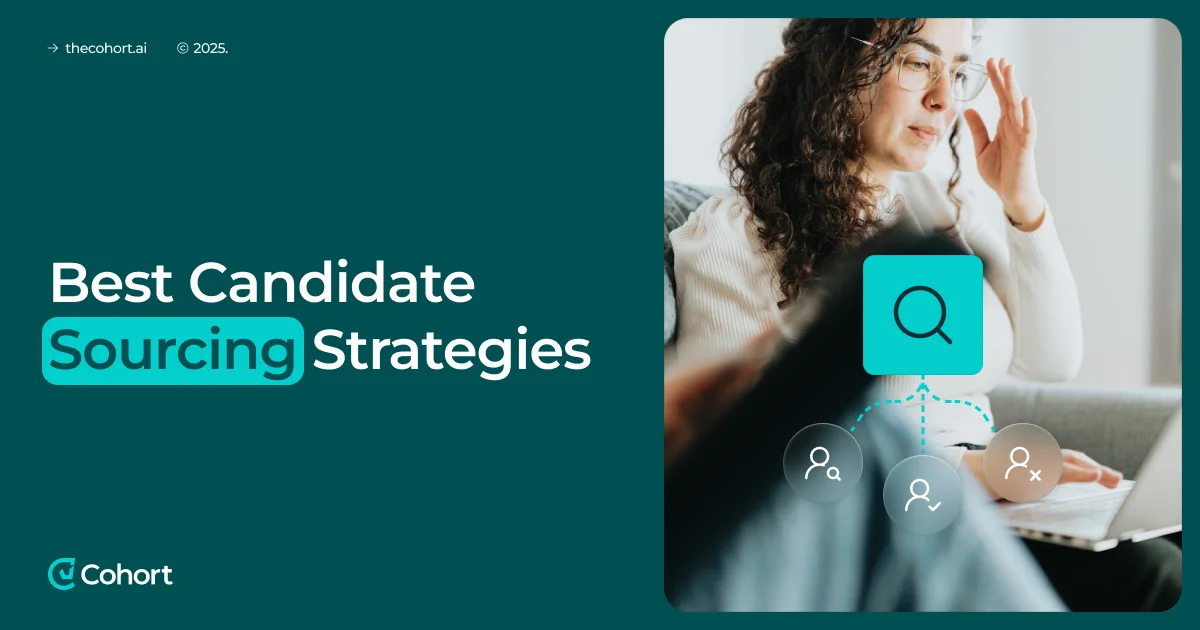Are you struggling to find the right candidates even with dozens of applications pouring in?
You are not alone, as recent reports have shown that 76% of employers continue to face difficulties in filling roles.
It appears that finding candidates with the right skills remains one of the most significant challenges for HR leaders and talent acquisition teams.
Today, we will explore how the best candidate sourcing strategies can transform the way recruiters identify, attract, and engage top talent in a hiring market.
Let’s start!
What is candidate sourcing?
Candidate sourcing involves actively seeking out individuals who could be a good fit for your open roles, even if they’re not currently applying.
Instead of waiting for applications, recruiters reach out to potential candidates and build connections early.

Why does candidate sourcing matter so much?
Candidate sourcing matters because it helps recruiters find better candidates more quickly and at a lower cost, even when most people aren’t actively looking for a job.
Here’s what makes candidate sourcing so important right now:
- Proactive, not passive: Only 25–30% of workers are actively looking for jobs, while 70–75% are passive candidates, open to new roles if approached directly.
- Better results: Sourced candidates are 5x more likely to be hired than inbound applicants, highlighting how targeted outreach outperforms general job board applications.
- Faster hiring: In the U.S., the average time-to-hire is around 36 days, which is about 8% faster than the global median, making efficient sourcing a key advantage.
- Lower costs: The average cost per hire rose from $4,129 in 2019 to $4,700 in 2023, with a 14% increase, making strategic sourcing a smart way to reduce hiring expenses.
10 Best candidate sourcing strategies to find top talent faster
Finding great candidates is more than just posting a job and waiting for people to apply.
Since most workers are not actively looking for a job, recruiters must be proactive, creative, and strategic in their job search approach.
“When you invest in sourcing, you're recognizing that talent is a priority for your company and that you want the best talent that can be had, not just the best of the talent that happens to be looking for work and happens to apply to your jobs.” Glen Cathey — What's the value of sourcing?
To begin with, here are some of the sourcing strategies that proved to be most effective in 2025:
- Use AI recruitment tools to identify and rank the best-fit candidates quickly.
- Automate outreach with smart follow-up sequences to save time.
- Leverage talent platforms that use machine learning for smarter matching.
- Analyze sourcing data to identify the channels that deliver the strongest candidates.
- Integrate sourcing tools with your Applicant Tracking System (ATS) to streamline your workflow.
Now, let’s explore sourcing strategies in greater detail:
1. Eliminate manual work with AI to boost accuracy and speed
AI has evolved beyond being just a trend, as it’s now a practical tool that helps recruiters source candidates efficiently and find the best ones with less manual effort.
While human sourcers have limitations on the number of profiles they can review, AI can quickly scan large datasets, identify hidden patterns, and uncover qualified candidates.
⚠️ Why it hurts:
Without AI, recruiters risk falling behind in both speed and effectiveness, as 98% of hiring managers say AI improves efficiency.
Additionally, AI tools have been shown to deliver a 52% faster time-to-hire, along with higher-quality candidates.
✅ What to do instead:
- Utilize AI resume parsers to extract skills and experience instantly.
- Utilize AI matching engines to surface the best-fit profiles and reduce hiring bias by focusing on skills over background noise.
- Adopt chatbots to answer candidate questions and gather initial information.
💡 Pro tip
Cohort AI’s Sally the Scout finds high-signal candidates across GitHub, LinkedIn, and more, so you can review real skills, not just polished profiles.
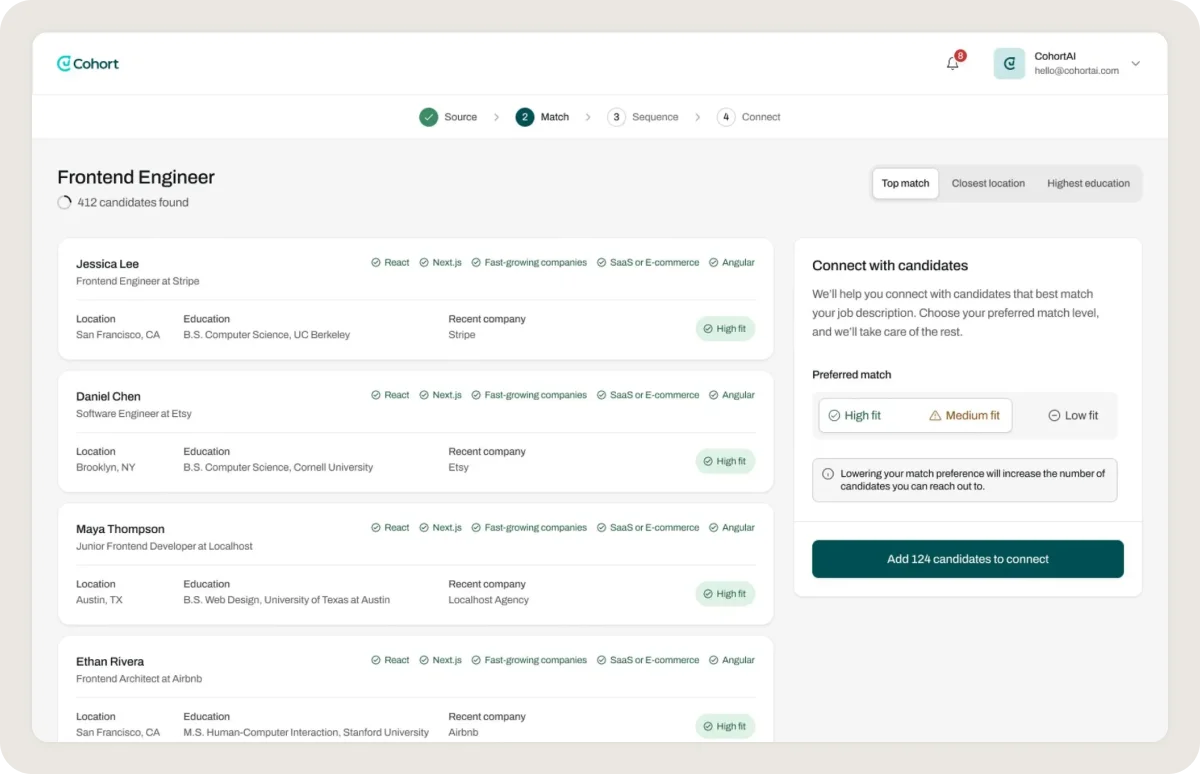
It delivers your top 3 candidates in days, not months, so your team moves faster without compromising on fit.
2. Automate follow-ups with smart sequences
Even great outreach often fails without good timing and consistent follow-up, as many recruiters send a single message and then move on.
But most candidates don’t reply to the first email, not because they’re not interested, but because they’re busy.
⚠️ Why it hurts:
Without follow-ups, reply rates tend to remain low, as a single follow-up can increase replies by 40%.
Additionally, top users achieve a 27% response rate with follow-ups, compared to a 16% response rate without them.
Skipping this step means missing out on engaged candidates.
✅ What to do instead:
- Use email sequences or recruiting CRMs to schedule follow-ups automatically.
- Send the next message a few days later, or after a relevant company update has been made.
- Utilize chatbots or AI messaging tools to respond to FAQs or re-engage candidates.
💡 Pro tip
Cohort’s Charlie the Closer handles nudging, Q&A, and post-interview engagement without the need for manual check-ins.
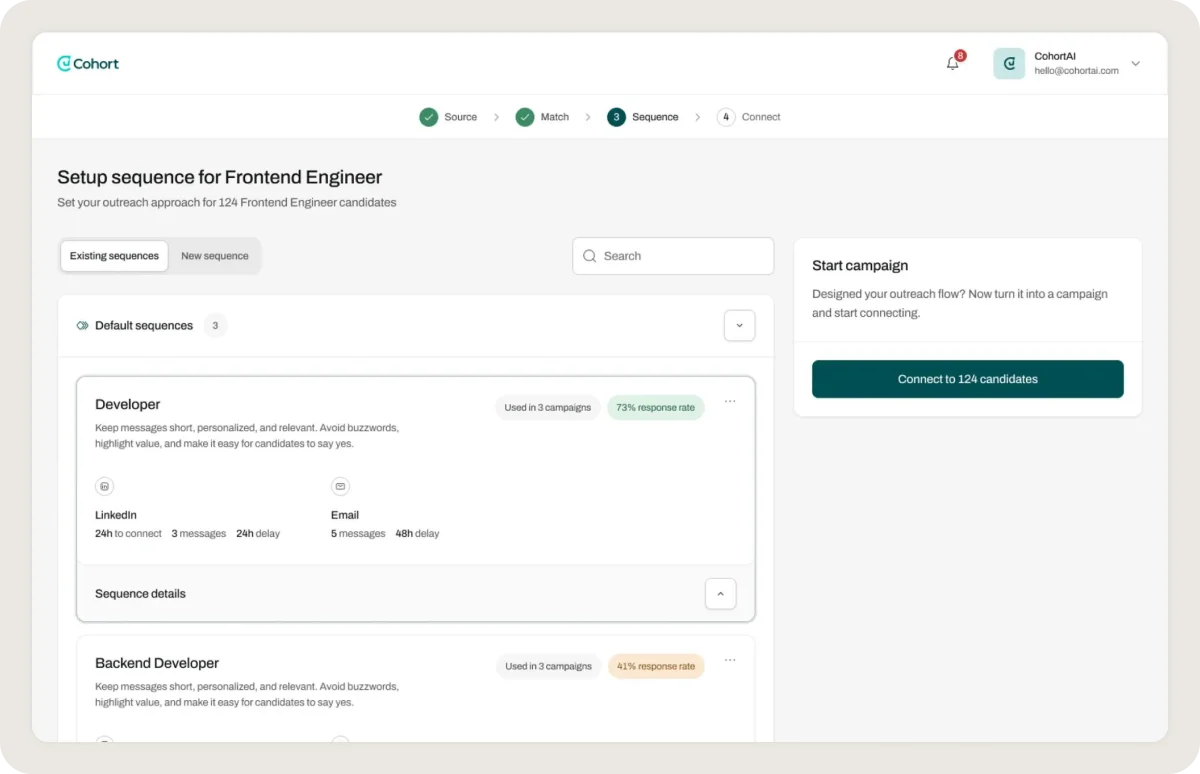
It prevents candidate drop-offs and keeps communication going, even when you’re not online.
3. Invest in tools that streamline sourcing
With the right tools, sourcing becomes faster, smarter, and far less manual.
In comparison, manually posting to job boards, sorting through resumes, and managing scheduling can take hours and often result in missed opportunities.
⚠️ Why it hurts:
Without automation, recruiters lose valuable time on tasks that could be streamlined.
Those using AI hiring tools save around 20% of their workweek, equivalent to a full day, by automating tasks such as writing job ads and outreach messages.
✅ What to do instead:
- Let the tools screen out unqualified applicants, allowing you to focus on quality.
- Add email automation, smart scheduling tools, and enrichment plugins that pull data from LinkedIn or GitHub.
- Utilize AI assistants that instantly surface profiles across platforms.
4. Use data to improve your sourcing strategy
Effective sourcing relies on data and ongoing improvement, rather than relying solely on guesswork or instinct.
When you don’t track what works, you waste time on the wrong channels or repeat the same mistakes.
⚠️ Why it hurts:
Recruiters face the challenge of sifting through hundreds of applications, yet only about 3%, which is roughly 3 out of every 100, are selected for interviews.
Without tracking which sources yield quality applicants, teams risk bloated pipelines, low ROI, and missed opportunities.
✅ What to do instead:
- Track source-of-hire using automation hiring tools to see where top candidates actually come from.
- Monitor pipeline velocity, response rates, and conversion metrics (e.g., interview-to-offer ratio).
- Set clear KPIs, such as time-to-first-contact or offer acceptance rate, and use dashboards to monitor progress.
💡 Pro tip
Cohort tracks how candidates move through your funnel and pinpoints where drop-offs or delays happen.
You get clear insight into what’s working and where to improve, backed by real-time sourcing data.
5. Leverage social media to connect
Today’s candidates, especially those who are passive, are spending their time on social platforms, not just job boards.
For instance, over 70% of U.S. workers are passive candidates, and without a strong social presence, they may never see your roles.
Even worse, your competitors are already there, building visibility and engaging the same talent.
⚠️ Why it hurts:
Social media is where candidates network, showcase projects, and follow brands they admire.
If you’re invisible online, top candidates may assume your company is outdated or disengaged.
✅ What to do instead:
- Utilize platforms such as LinkedIn, Twitter (X), Facebook, Instagram, and even Reddit or TikTok, depending on your target audience.
- Interact with candidates’ posts, such as comments, likes, and messages, with personalized outreach.
- Optimize for mobile, as 80% of job applications from Gen Z are submitted via smartphones.
6. Personalize every outreach message
Generic cold outreach is no longer effective, as candidates expect thoughtful, tailored communication.
Mass emails or templated messages often come across as lazy and impersonal.
If your message starts with “Dear [role] seeker” or sounds like a copy-paste pitch, it’s likely to be ignored.
⚠️ Why it hurts:
Personalized messages can increase response rates by up to 50%, while generic outreach often gets overlooked.
If you don’t tailor your message, you’ll lose talent to companies that do.
✅ What to do instead:
- Start with their name and reference something specific from their background or social media profile.
- Highlight how the role fits their goals, not just your company’s needs.
- Run A/B tests on subject lines or messaging styles to learn what works best with different personas.
💡 Pro tip
Cohort’s Pete the Prospector generates tailored outreach using your brand voice and each candidate’s public profile.
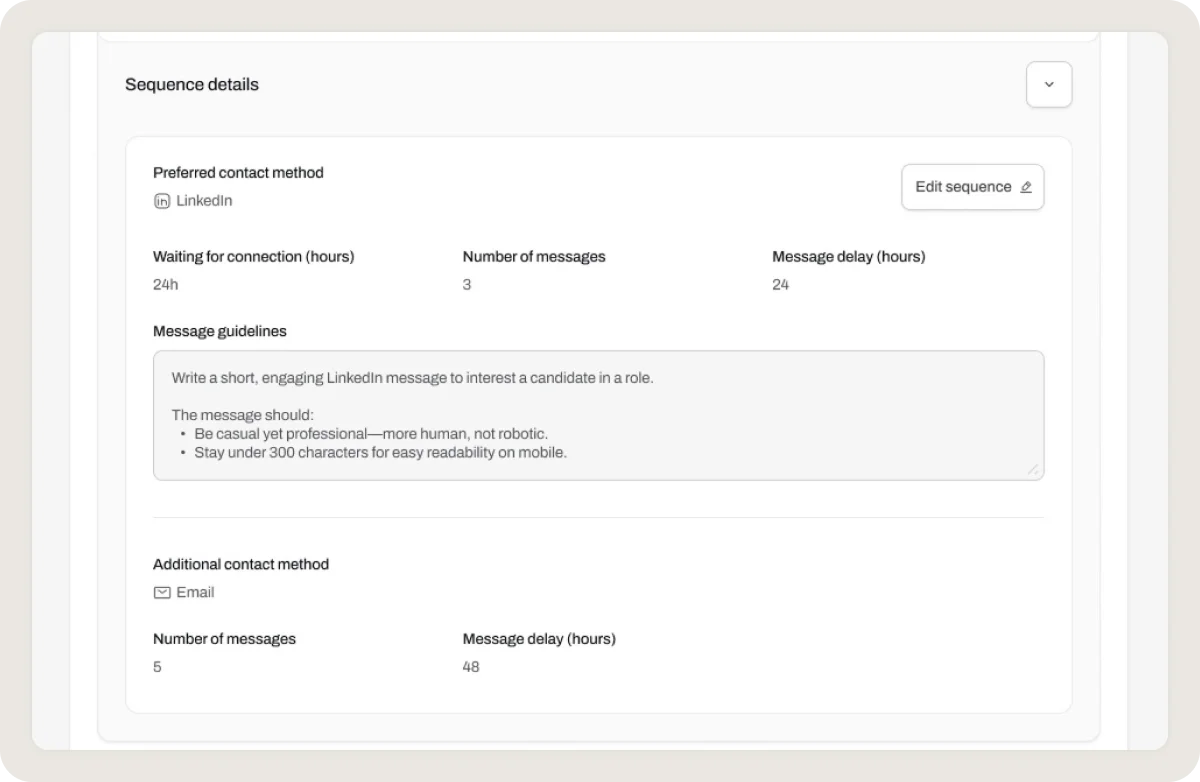
You get messages that feel personal and relevant, without spending hours crafting them manually.
7. Use a mix of sourcing channels
If you only source from the same platforms every time, you risk missing entire groups of qualified candidates.
For example, LinkedIn dominates in volume, accounting for 76% of saved jobs.
However, platforms like Government Jobs, HelloWork, and Wellfound deliver significantly better callback rates.
If you rely only on the biggest names, you might miss out on top candidates hiding in less crowded spaces.
⚠️ Why it hurts:
This overreliance leads to crowded pipelines and missed opportunities.
Different types of talent utilize different platforms, and sticking to one means missing out on where they are.
✅ What to do instead:
- Combine mainstream job boards with niche platforms tailored to specific industries.
- Use Boolean search on Google, Reddit, and relevant online communities.
- Don’t forget about offline spaces, such as meetups, events, or referrals.
💡 Pro tip
Cohort AI’s Sally the Scout scans multiple platforms, including GitHub, LinkedIn, and niche communities, to surface talent that traditional tools overlook.
It helps you tap into hidden candidate pools and avoid the noise of oversaturated job boards.
8. Reengage past and existing candidates
Some of your best future hires may already be in your database, but maybe you just haven’t reached out again.
According to ADP’s 2025 payroll data, boomerang hires accounted for an average of 27% of new hires since 2018, and as of March 2025, that number had risen to 35%.
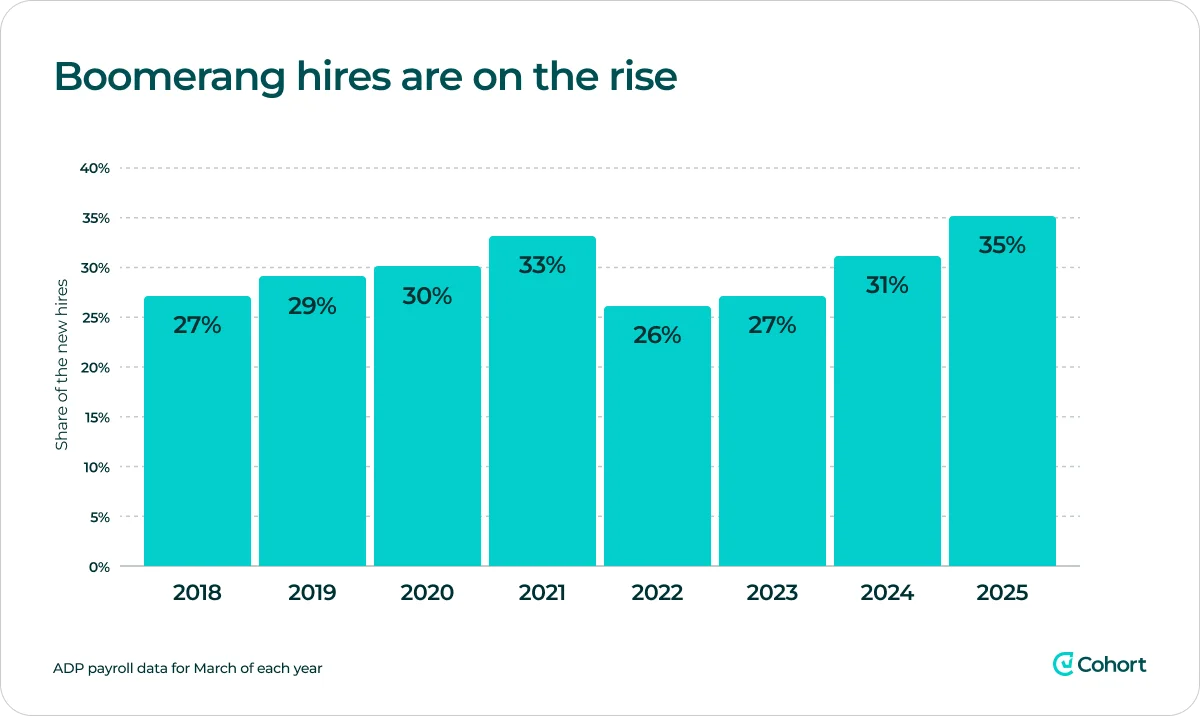
That’s a clear sign: past candidates are still very much in play.
⚠️ Why it hurts:
Every ignored resume or forgotten referral is a lost opportunity, because candidates you connected with six months ago may now be a perfect fit.
✅ What to do instead:
- Search your ATS for past applicants who were strong but didn’t get the job.
- Reach out to silver medalists and pipeline candidates for new roles..
- Send personalized messages via email, text, or LinkedIn to reignite interest.
9. Understand the job before you start sourcing
Sourcing without truly understanding the role is like searching with a blindfold, as you’ll miss key details and waste valuable time.
When recruiters skip the deep dive, they often overlook crucial skills, certifications, or soft skills that are most important.
This leads to mismatched candidates, frustrated hiring managers, and a sourcing process that feels off from the start.
⚠️ Why it hurts:
Poor job understanding results in weak candidate pipelines, repeated screening calls, and a loss of credibility.
✅ What to Do Instead:
- Refine the job description if it’s too vague or outdated.
- Ask for examples of past top performers or hires that didn’t work out, and why.
- Analyze feedback on previously rejected candidates to spot hidden patterns.
10. Align closely with hiring managers
Many recruiters begin sourcing candidates before fully understanding the role, resulting in wasted time and missed opportunities.
When recruiters aren’t aligned with hiring managers, they often chase the wrong candidates.
In fact, 77% of organizations report being impacted by the IT skills gap, and without clear role definitions, it becomes even harder to close that gap.
⚠️ Why it hurts:
Miscommunication delays hiring and slows down momentum.
The result is that good candidates lose interest or accept offers elsewhere while teams scramble to recalibrate.
✅ What to do instead:
- Create a shared candidate profile with the hiring manager.
- Run a few test searches together to calibrate on profiles and platforms.
- Keep communication open and ask for feedback on candidate quality and outreach efforts.
Cohort AI: The future of efficient candidate sourcing
Cohort AI revolutionizes sourcing by embedding generative AI at every stage of the hiring process, from identifying hidden talent to personalizing outreach and ranking candidates.

It helps recruiters cut through noise, engage the right people faster, and build stronger pipelines without increasing workload.
Its intelligent agents take care of the heavy lifting while keeping sourcing human, focused, and effective.
Here’s how Cohort AI brings sourcing into the future:
- Smarter discovery: Sally the Scout surfaces high-quality, passive candidates based on skills, public projects, and behavioral signals, eliminating the need for endless scrolling.
- Personalized outreach at scale: Pete the Prospector crafts tailored messages using GenAI trained on your brand voice, tone, and role requirements.
- Intelligent ranking: Candidates are scored and sorted using The Talent Graph, which looks beyond titles to evaluate fit, growth potential, and working style.
- Consistent follow-up: Charlie the Closer automates follow-up sequences and answers FAQs, so no warm lead slips through the cracks.
- Shortlists you can trust: Get pre-vetted top candidates fast, so your team can focus on interviewing, not filtering.
Whether you’re scaling up or just want to improve sourcing quality, Cohort AI delivers faster results, better matches, and more time to focus on people.
Want to stop losing great candidates to faster teams?
Book a free demo today and see how AI-powered sourcing can change your hiring game.



